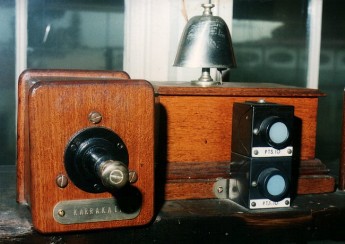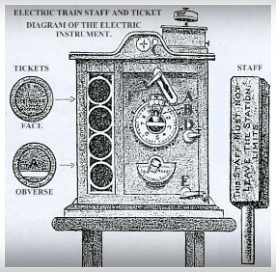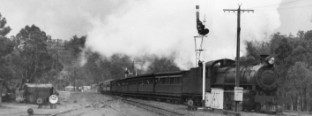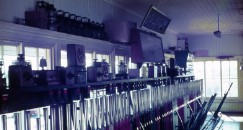SIGWA Newsletter

One Bell is the W. A. G. R. Bell Code for 'Call Attention' and is seen as the fitting name for the 'On-Line' news page of the Signalling Interest Group of Western Australia (S.I.G.W.A.). It incorporates news from the Claremont Signal Cabin Group.
Notes from observers of current signalling alterations are also encouraged. Please submit all articles for consideration of inclusion in this newsletter to The Editor
Permission must be sought from the site owner before the information on this page is used for any purpose other than personal education.
29th July 2006: Restoration of Smith’s Mill (Glen Forrest) Railway Signal
The old semaphore Home Signal in Morgan John Morgan Reserve Glen Forrest was restored in time for the 2006 Trek the Trail, thanks to a unique partnership between local heritage groups and businesses. Trek the Trail is the Shire of Mundaring's premier annual community event. Cyclists, runners, and walkers "put their sole into it" each year by trekking over a different section of the former railway formation Heritage Trail. This year's route was between Mundaring and Darlington and therefore passed through Glen Forrest. The remains of the Glen Forrest Distant were also passed on the way, but it is unlikely that many would have recognised these ruins. The Home Signal however was easily recognisable, yet was in a very poor condition.
In the years since the closure and removal of the line, the signal had stood as the sole remnant of the railway station which was once located in the hills suburb now known as Glen Forrest. As some of the parts of the signal were damaged by years of exposure and could have caused a significant safety hazard if left unaddressed. Accordingly, an authentic replacement signal arm was donated by S. I. G. W. A. member Chris French and conserved by Ruth McCole of the Mundaring and Hills Historical Society. Time was also taken to re-glaze the Spectacle Plate.
With the aid of a cherry picker provided by Total Tree Services, the parts were then installed and painted by Chris and Ruth, with paint donated by Glen Forrest Hardware Store. Ms McCole said that the classic semaphore signal was installed at the former Smith’s Mill Station in 1913. It is now one of the few (and possibly the only) signal of its type in the State still in its original location.
Smith’s Mill was a very busy station in its heyday. In 1893, the outward tonnage of goods exceeded its nearest rival, Fremantle, by more than 1,000 tonnes.
Soon after the above restoration work on this signal was carried out, this historic signal was altogether removed from the site. Initially, we were not made aware of what happened to the signal or to where the donated parts had gone.
STOP PRESS! SignallingWA has since been advised that the Signal post had been found to have suffered White Ant damage in the 'in-ground' part of the post, and was removed for safety reasons. Whilst another post was sourced, this apparently was found to be unsuitable, and efforts are now underway to obtain another replacement post. Watch this space for future developments!
19th September 2004: In an effort to make signalling history more widely available, Chris. J. E. French, founder of the Signalling Interest Group of W. A. has published "Signal Cabins in Western Australia". Edited and published by fellow historian Ruth McCole of Historical Highlights, the book contains 30 signal cabins previously featured on the former Signalling Interest Group of W. A.'s web site. The book incorporates a removable binding that permits the updating of pages (when subsequently issued) with the intention of creating an expandable signalling resource. Details and Orders
9th September 2001: In a further attempt to source elusive information about the W. A. G. R.'s Electric Train Staff and Ticket instruments, manufactured by the Railway Signal Co. of Liverpool, England. A letter has been sent to the Signal Record Society in England. This has subsequently been published in the Sept. / Oct. 2001 edition (No.89) of "The Signalling Record" - but without the illustration which was sent. Here is the image that should have been published for those interested.
20th January 2000: The latest word back from knowledgeable sources in England regarding the Electric Train Staff and Ticket once used by the W.A.G.R. and reported in "One Bell" on 21st September is, quote: "You have stumbled upon a great mystery here!" So, the quest for enlightenment continues..!

17th January 2000: S.I.G.W.A. placed a repeat advertisement in the West Australian newspaper's Can You Help? column seeking assistance with the project and or the donation of material, stories, photographes, etc. In response to this,in the week that followed, four responses have been received, this time mainly via electronic media (telephone & e-mail). As a result of this least there is at least one potential new volunteer for S.I.G.W.A. We look forward to meeting him shortly.
11th January 2000: A new database has been set up to record all the Diagrams of Signalling currently held by S.I.G.W.A. - there are quite literally hundreds yet to input, so this will become part of our "on-going" tasks.
10th December 1999: At the 465th general meeting of the A.R.H.S. (W.A. Div. Inc.) S.I.G.W.A. (and A.R.H.S.) member Chris French offered to undertake a 'stocktake' of the signalling equipment recently donated to the Rail Transport Museum by Westrail following the closure of the signal maintenance workshops at Forrestfield. It has since seemed prudent to extend this offer so that a complete picture of the signalling equipment held at the museum can be ascertained.
Also, the manning of the museum's signal cabin for RailFest 2001 by S.I.G.W.A. has been offered. We hope to be putting together an interpretive program for the signal cabin similar to the one currently in use in the Claremont Cabin. The museum's cabin has an interesting history in itself, being a combination of the Carlisle structure, surrounding the Maddington cabin's lever frame and depicting the era of two-position block working! Explaining all this will certainly be a challenge!
21st September 1999: S.I.G.W.A. member Chris. J. E. French has uncovered evidence of the former existence and use in Western Australia of a form of railway safeworking previously unknown to S.I.G.W.A. members - Electric Train Staff and Ticket. An image of instruments has been found which clearly shows the maker's name, and the operating rules for their use on the W.A.G.R. are being transcribed. More information on their useage, and the sections over which these instruments were used is required, so if anyone has any information, this will be gratefully received. The search for additional information is shrouded in confusion however, as there seems to have been some 'mis-information' about the correct name for the 'tickets' - these being possibly (and more correctly) named 'tokens'. The quest for clarity continues..!
6th September 1999: S.I.G.W.A. placed an advertisement in the West Australian newspaper's Can You Help? column seeking assistance with the project and or the donation of material, stories, photographes, etc. In the week that followed, five responses were forthcoming; two from retired W.A.G.R. Signalmen, and the rest from relatives of former Signalmen, but now, sadly deceased.
Retired Karrakatta and Mount Lawley Signalman Arthur Brean has submitted a batch of black and white negatives for the production of prints. These are real 'gems' and show a very different Mount Lawley than can be seen today. One image clearly shows the interior of the Mount Lawley Signal Cabin and this is just the sort of information that we hoped to uncover. Others have sent in personal reminiscences which adds volumes to the personal element of the facts gathered. S.I.G.W.A. thanks all those that replied, and look forward to further developments in the future.
25th June 1999: S.I.G.W.A. was pleased to receive from Mr. Geoff Smith, a fellow railway researcher, some personal reminiscences and two photographs of the Electric Staff cabin at Shotts, which is between Collie and Muja in the state's South Western coal district. Thanks Geoff, that's just the sort of information that adds the human touch to our research.
Saturday 5th - Monday 7th June 1999: Members of S.I.G.W.A. were pleased to present a display at Perth's annual Australian Model Railway Association's 1999 Model Railway Exhibition. 5759 visitors came to the exhibition, and there was a great deal of interest shown in our stand over the three days. Many people were seemingly mesmerized by the workings of the model interlocking frame and explanations of Staff and Ticket working. A PC presentation was running on the Sunday and Monday explaining what S.I.G.W.A. is doing, and how. Many demonstrations were given of the S.I.G.W.A. web site, also loaded onto the PC. At the trophy presentations, the group was considerably heartened by the news that we rated a mention (as a 3rd place runner-up) to a trophy as 'Best presented non-trade stand'. Not bad for technically the group's first 'outing', maybe next year, we will do even better!
Special thanks must go to Morris Cooper of Armadale, (the person in charge of the signals at the Castledare Miniature Railway), who has provided some photocopies of articles of the W.A.G.R. Eastern Railway colour light resignalling project of 1962 / 1963. These photocopies have given us a valuable insight into the project as presented at the time of its implementation, and have revealled some clues to the origins of the 3 position block instruments used by the W.A.G.R. Thanks again Morris!
Sunday 21st - 30th March 1999: Members of S.I.G.W.A. were pleased to be of assistance to interstate visitor and member of the Signalling Record Society (Victoria) - Chris Guy. Chris is on a short holiday from Victoria, and was shown the Claremont Signal Cabin, and the signalling on the Bennett Brook Railway, Whiteman Park. Also, (whilst S.I.G.W.A. members returned to paid work), Chris travelled the country side, finding the last remnants of our once prolific signalling system. His report of the current state of the derelict Narrogin cabin was disturbing. Before returning east, Chris will be visiting the A.R.H.S. museum at Bassendean (and he hopes, time permitting) the Northam Railway Preservation Society's museum in the old station Northam.
Sunday 21st February 1999: Another visit to the Bennett Brook railway ended up in an impromptu discussion regarding 'approach locking' in W.A.G.R. lever cabins, and the best way this could be carried out for the Subiaco cabin when connected up to its new home.
Sunday 14th February 1999: A visit to the Bennett Brook Railway to view the relocated Subiaco Signal Cabin turned into a bit of a 'Busman's holiday'. An initial tour of the cabin, revealed it was well on the way to being put back together. The catch-handle spring boxes removed from some levers during the re-location were re-bolted, and the electrical interlocking in the 'between decks' area (interlocking room) was disabled.


